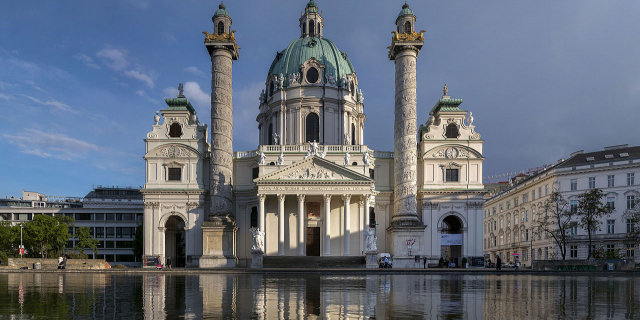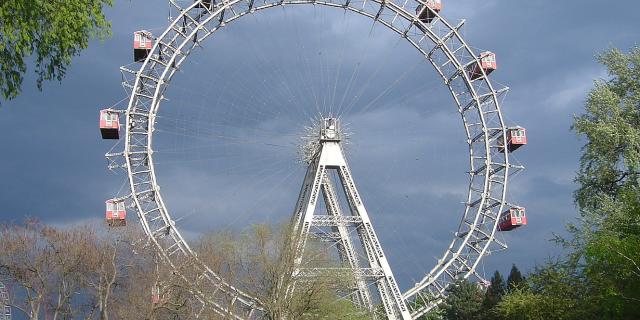Parlamentsgebäude (Wien)
( Austrian Parliament Building )The Austrian Parliament Building (German: Parlamentsgebäude, pronounced [paʁlaˈmɛnt͡sɡəˌbɔɪ̯də] colloquially das Parlament) in Vienna is where the two houses of the Austrian Parliament conduct their sessions. The building is located on the Ringstraße boulevard in the first district Innere Stadt, near Hofburg Palace and the Palace of Justice. It was built to house the two chambers of the Imperial Council (Reichsrat), the bicameral legislature of the Cisleithanian (Austrian) part of the Austro-Hungarian Empire. Since its construction, the Parliament Building has been the seat of these two houses, and their successors—the National Council (Nationalrat) and the Federal Council (Bundesrat)—of the Austrian legislature.
The foundation stone was laid in 1874; the building was completed in 1883. The architec...Read more
The Austrian Parliament Building (German: Parlamentsgebäude, pronounced [paʁlaˈmɛnt͡sɡəˌbɔɪ̯də] colloquially das Parlament) in Vienna is where the two houses of the Austrian Parliament conduct their sessions. The building is located on the Ringstraße boulevard in the first district Innere Stadt, near Hofburg Palace and the Palace of Justice. It was built to house the two chambers of the Imperial Council (Reichsrat), the bicameral legislature of the Cisleithanian (Austrian) part of the Austro-Hungarian Empire. Since its construction, the Parliament Building has been the seat of these two houses, and their successors—the National Council (Nationalrat) and the Federal Council (Bundesrat)—of the Austrian legislature.
The foundation stone was laid in 1874; the building was completed in 1883. The architect responsible for its Greek Revival style was Theophil Hansen. He designed the building holistically, aiming to have each element harmonising with all the others. He was therefore also responsible for the interior decoration, such as statues, paintings, furniture, chandeliers, and numerous other elements. Hansen was honoured by Emperor Franz Joseph with the title of Freiherr (Baron) after its completion. Following heavy damage and destruction in World War II, most of the interior has been restored to its original splendour.
The parliament building covers over 13,500 square meters, making it one of the largest structures on Ringstraße. It contains over one hundred rooms, the most important of which are the Chambers of the National Council, the Federal Council, and the former House of Deputies (Abgeordnetenhaus). The building also includes committee rooms, libraries, lobbies, dining rooms, bars and gymnasiums. One of the building's most famous features is the Pallas Athena fountain in front of the main entrance, built by Carl Kundmann after plans from Hansen, from 1898 to 1902 and it is a notable Viennese tourist attraction.
The Parliament Building is the site of important state ceremonies, most notably the swearing-in ceremony of the president of Austria. The building is closely associated with the two parliamentary bodies, as is shown by the use of the term Hohes Haus as a metonym for "Parliament". Parliamentary offices spill over into nearby buildings, such as the Palais Epstein.
After five years of renovations, the building reopened in 2023.
 Provisional House of Deputies building, view from Votive Church, 1860s
Provisional House of Deputies building, view from Votive Church, 1860sThe constitution known as the February Patent promulgated in 1861 created an Imperial Council as an Austrian legislature, and a new building had to be constructed to house this constitutional organ. The original plan was to construct two separate buildings, one for the House of Lords (Herrenhaus) and one for the House of Deputies (Abgeordnetenhaus). However, after the Austro-Hungarian Compromise (Ausgleich) which effectively created the Dual-Monarchy in 1867, the Kingdom of Hungary received its own separate legislative body, the re-established Diet, and the original plan for two buildings was dropped.
The precursor to the present building was the temporary House of Representatives, located on Währinger Straße, a street off the newly laid out Ringstraße boulevard. It was erected within six weeks in March and April 1861 according to plans designed by Ferdinand Fellner, a famous Austrian theatre architect. In its layout with a ramp and a lobby area, the Abgeordnetenhaus was a model for the later Parliament Building. Completed on 25 April 1861 this temporary structure was opened by Emperor Franz Joseph I of Austria, and soon afterwards mocked Schmerlingtheater, after Minister Anton von Schmerling. It was used by the deputies of Cisleithania until the completion of the present-day parliament building in 1883, while the House of Lords met at the Estates House of Lower Austria, then the seat of the Lower Austrian Landtag assembly.
Construction Ringstraße and Parliament Building around 1900
Ringstraße and Parliament Building around 1900The site for the new building was on the city's ancient fortifications and walls. In his famous decree Es ist Mein Wille of 1857, Emperor Franz Joseph I had laid down plans for the Ringstraße to replace the old city walls. The parliament building was supposed to feature prominently on the boulevard, in close proximity to Hofburg Palace and the Vienna City Hall.
An Imperial Commission was appointed to consider a design for a Parliament building. Influenced by the industrialist and politician Nikolaus Dumba, the Commission decided that its style should be classical, the argument being that classical Greek architecture was appropriate for a Parliament because of the connection to the Ancient Greeks and the ideal of democracy. After studying rival proposals, the Imperial Commission chose the plan by Theophil Hansen, who could rely on his drafts for Zappeion Hall in Athens. In 1869 the k.k. Ministry of the Interior gave von Hansen the order to design the new Austrian parliament building.
Ground was broken in June 1874; the cornerstone has the date "2 September 1874" etched into it. At the same time, work also commenced on the nearby Kunsthistorisches Museum and Naturhistorisches Museum on Maria-Theresien-Platz, the City Hall, and the University. In November 1883 the offices of the House of Representatives were completed and put to use. On 4 December 1883 the House of Representatives held its first session under its president, Franz Smolka. On 16 December 1884 the House of Lords under its president, Count Trauttmansdorff, held its first session. Both chambers would continue to meet in the building until the end of the Austro-Hungarian Empire in 1918.
The official name of the building was Reichsratsgebäude (Imperial Council Building), and the street behind the building, the Reichsratsstraße, still recalls this former name. The word "Parliament" however was in use since the beginning as well.
Building historyThe building saw tumultuous years during the late years of the declining multi-ethnic Austrian monarchy stretching from Dalmatia to Bukovina, as the House of Representatives was extremely fractious with tensions among liberals and conservatives, German nationalists and Young Czech deputies, as well as between the government and parliament. It became notorious for filibusters, parliamentary brawls and undisciplined deputies throwing inkwells at each other as a common feature. The joke on the Viennese streets was that Athena was so disgusted by the political infighting that she deliberately turned her back to the building. Nevertheless, the building housed the first form of a parliamentary system for many of the people of Central Europe. Some of the former deputies continued their political careers after the dissolution of the Empire and became important politicians in their home countries.
The Reichsratsgebäude continued to function until 1918, when the building was occupied by demonstrators during the disintegration of the Austro-Hungarian Empire. From 21 October 1918 the remaining German-speaking deputies convened in a "Provisional National Assembly", first at the Palais Niederösterreich, from 12 November onwards in the Parliament Building. On that day the presidents of the assembly officially proclaimed the Republic of German-Austria from the ramp in front of the building. Upon the Austrian Constitutional Assembly election in 1919 and the establishment of the First Austrian Republic, the building itself was renamed the Parlament, with the new republican National Council (Nationalrat) and Federal Council (Bundesrat) replacing the old Imperial House of Deputies (Abgeordnetenhaus) and the House of Lords (Herrenhaus).
 The parliament in session in 1930
The parliament in session in 1930The parliament was incapacitated, when on 4 March 1933 Chancellor Engelbert Dollfuß took the occasion of a parliamentary law quarrel to cease its function, the first step to the introduction of his Austrofascist dictatorship. By the imposed "May Constitution" of 1934 the Parliament Building became the seat of the Bundestag, the formal legislature of the Federal State of Austria. It finally lost its function with the Austrian Anschluss to Nazi Germany in 1938. The Nazis used it as an administrative seat of the Vienna Reichsgau. During the Second World War, half of the building suffered heavy damage by Allied bombing and the Vienna Offensive. Parts of the interior, such as the former House of Lords Chamber and the Hall of Columns, were completely destroyed.
It was in the old Abgeordnetenhaus Chamber that the new Chancellor Karl Renner on 27 April 1945 declared the rebirth of an independent Austria, backed by Soviet troops. Max Fellerer and Eugen Wörle were commissioned as architects; they chose to redesign and readapt the former Lords Chamber for the National Council, and in the process the meeting room of the National Council was rebuilt in a Modern and functional style. Work on the National Council Chamber was completed in 1956. The original appearance of the other publicly accessible premises, such as the Hall of Columns, and the building's external appearance were largely restored to von Hansen's design.

































Add new comment